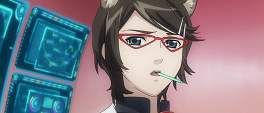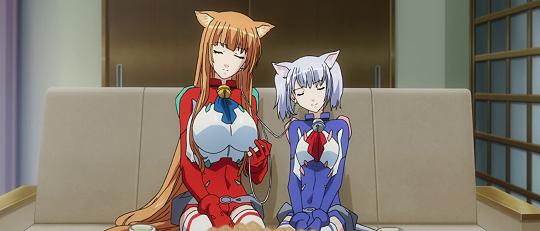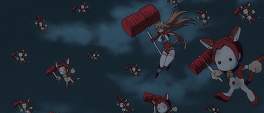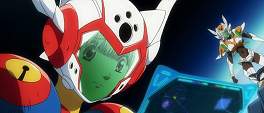The formula is all too familar: alien lands on earth, befriends local youth and romantic hijinks ensue. The opening episodes of Asobi ni iku yo! do nothing to tweak this formula beyond adding cat-ears and a tail to the buxom interplanetary interloper. The recent Ano Natsu de Materu at least kept things clean, here the feline Eris is disrobed and in the protagonist's bed within minutes. Seconds later and the domineering childhood friend arrives (how inconvenient!) and the quiet and traditional Japanese beauty follows shortly afterwards.
Those who, somewhat rightly, switch off after those episodes though would be missing what turns out to be a surprisingly entertaining romp through science fiction of old and a locale less travelled: Okinawa.
Certainly many other series have been set during summer but few can match the atmosphere and detail lavished upon this southern microcosm of Japan as it is here. Aquamarine skies and crystal waters drift into an August sunset as little details like the swaying fronds to the protagonists' clothing shine through. Attention is lavished on the culinary delicacies as evidenced by the throes of ecstasy that the extraplanetary tourists experience everytime a bite is taken; this could be as much a "Visit Okinawa" advert as an anime series.
It's pleasing to be so wholly transported to a place though. Whereas other series ostensibly take place during a Tokyo summer, few are able to ground themselves so wholly. More often they take place in a faceless suburbia of prefab houses or the unreality of a faux-European school of palatial grounds and impossibly equipped classrooms. Fewer series still manage to really grasp the heart of a season, here the youthful abandon of spending carefree time with friends is as much a character as the gaudy pin-up girl alien. Both Onegai Twins and Ano Natsu de Materu share that holiday thrill, just as much as Five Centimeters Per Second and Aoi Bungaku's "No Longer Human" story capture the spirit of winter and make the environment a character rather than merely a backdrop.
From the outset then it's clear that Okinawa is an island that doesn't take itself too seriously. Mourning a loved one with a party of meat, alcohol and dancing would be quaint enough, but here there's a cat-eared, skin-suited alien dancing along with them with nary an eyebrow raised. Western countries would be aghast that this is humanity's momentous first contact, here the locals are decidedly blasé. Alongside the sun-drenched tone the series quietly asks for the audience to take this special kind of absurdity to heart and not scrutinise too closely.
For instance, why would these aliens with cat ears also have human ears? Ones which serve the intended purpose as evidenced when using ear-bud headphones. Why would every Catian be female? Are stereotypical gender roles reversed in their advanced culture and the males stay at home to look after the kittens? Ignore too the copious hand-waving: of course Aoi's glasses can see infra-red. And of course Kakazu can fit inside Eris' clothing (and vice versa).
The joy the series takes in its own silliness is a large part of its charm and beyond the trope-filled first third ("my reproductive systems have fully matured") other aspects of its character are able to come to the fore. Historical science fiction undertones begin to be paid more than lip-service as a Captain Future reference is followed by a Neil R. Jones namedrop then innumerable others in the laser-battle climax of the series. You could even level a hat-tip to Red Dwarf with the revelation that Catians evolved from (rather than into) cats.
There is a sensitivity to its sources though that the ditzy exterior belies with a genuinely heartfelt take on android autonomy and robot perception nestled in between and sing along by the cast members and a blatant Wacky Races reference with the leader of the Dogian antagonist. The series even mocks itself with a group dedicated to pursuing a "beautiful" first contact outwardly lamenting the seemingly low-brow cat-girl conceit.
The casual approach to nudity is never replaced, it only stops being the focus and instead settles into a less frantic, almost zen-like approach that GAINAX usually takes. The Catian delegates may come in all heights, chest sizes and dispositions - enough to satisfy any predilection including fans of the military tough-girl - but it's hard to begrudge the series when it can introduce anti-matter bullets which evaporate everything but the living. Ripe for declothing, certainly, but can carve up tanks as much as they do brassieres.
A happy-go-lucky disposition only takes the series so-far though and some story threads are left dangling. Aoi's latent ability to transport objects is unexplained just as the mention of magicians and Ichika's spiritual seals juxtapose the kitschy science otherwise on display. Similarly the fanatical cat-ear religion "Underside of the kitten's paw" veers perilously close to annoying but somehow manages to come off as weirdly believeable, especially if you are in any away familiar with Japanese otaku culture.
Asobi ni iku yo! then is an enjoyable hodge-podge of a series. The brilliant location and atmosphere isn't enough to excuse the rampant tawdriness of the opening episodes or the casual sexism of the later ones, but at its heart this is a fun, sometimes affecting, sometimes poignant but most of all ludicrous series that is easy to write off but hard to put down.









